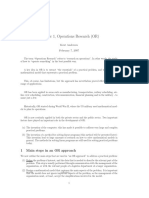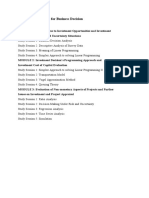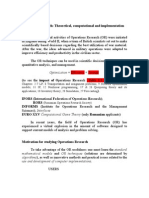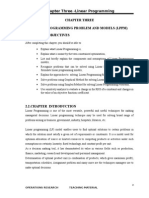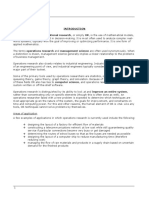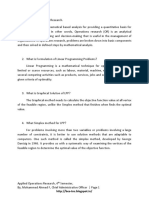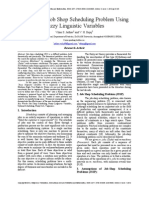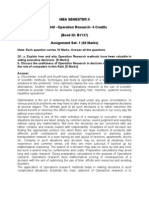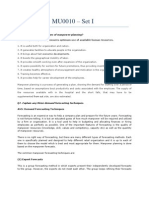MB0048 Set 1 & 2
MB0048 Set 1 & 2
Uploaded by
Shravanti Bhowmik SenCopyright:
Available Formats
MB0048 Set 1 & 2
MB0048 Set 1 & 2
Uploaded by
Shravanti Bhowmik SenOriginal Description:
Copyright
Available Formats
Share this document
Did you find this document useful?
Is this content inappropriate?
Copyright:
Available Formats
MB0048 Set 1 & 2
MB0048 Set 1 & 2
Uploaded by
Shravanti Bhowmik SenCopyright:
Available Formats
Spring 2012, MBA-2nd Semester
ASSIGNMENT SET 1 1. A toy company manufactures two types of dolls, a basic version doll-A and a deluxe version doll-B. Each doll of type B takes twice as long to produce as one of type A, and the company would have time to make maximum of 1000 per day. The supply of plastic is sufficient to produce 1000 dolls per day (both A & B combined). The deluxe version requires a fancy dress of which there are only 500 per day available. If the company makes a profit of Rs 3.00 and Rs 5.. per doll, respectively on doll A and B, then how many of each doll should be produced per day in order to maximize the total profit. Formulate this problem. Formulation: Let X1 and X2 be the number of dolls produced per day of type A and B, respectively. Let the A require t hrs. So that the doll B require 2t hrs. So the total time to manufacture X1 and X2 dolls should not exceed 2000t hrs. Therefore, tX1 + 2tX2 2000t Other constraints are simple. Then the linear programming problem becomes: Maximize p = 3 X1 + 5 X2 Subject to restrictions, X1 + 2X2 2000 (Time constraint) X1 + X2 1500 (Plastic constraint) X2 600 (Dress constraint) And non-negatively restrictions X1, X2 0
2. What are the advantages of Linear programming techniques? 1. The linear programming technique helps to make the best possible use of available productive resources (such as time, labor, machines etc.) 2. It improves the quality of decisions. The individual who makes use of linear programming methods becomes more objective than subjective.
MB0048: Operations Research Page 1 Roll No. : 541110058
Spring 2012, MBA-2nd Semester
3. It also helps in providing better tools for adjustment to meet changing conditions. 4. In a production process, bottle necks may occur. For example, in a factory some machines may be in great demand while others may lie idle for some time. A significant advantage of linear programming is highlighting of such bottle necks. 5. Most business problems involve constraints like raw materials availability, market demand etc. which must be taken into consideration. Just we can produce so many units of product does not mean that they can be sold. Linear programming can handle such situation also.
3. Solve the following Assignment Problem Operations O1 O2 O3 M1 10 9 15 M2 15 10 16 M3 12 9 16 M4 11 12 17
Since the number of rows are less than number of columns, adding a dummy row and applying Hungarian method, Row reduction matrix Operations O1 O2 O3 O4 M1 10 9 15 0 M2 15 10 16 0 Optimum assignment solution Operations O1 O2 O3 O4 M1 [0] x 1 x M2 5 1 [0] x M3 2 [0] x x M4 1 3 x [0] M3 12 9 16 0 M4 11 12 17 0
Hungarian Method leads to multiple solutions. Selecting (03, M2) arbitrarily. O1 M1 10
Roll No. : 541110058
MB0048: Operations Research Page 2
Spring 2012, MBA-2nd Semester
O2 M3 O3 M2
09 16
O4 M4 00 ------------------------TOTAL 35 Therefore, the optimum assignment schedule is O1 M1, O2 M3, O3 M2 AND O4 M4.
4. What is integer programming? If the unknown variables are all required to be integers, then the problem is called an integer programming (IP) or integer linear programming (ILP) problem. In contrast to linear programming, which can be solved efficiently in the worst case, integer programming problems are in many practical situations (those with bounded variables) NP-hard (nondeterministic polynomial-time hard), in computational complexity theory, is a class of problems that are, informally, "at least as hard as the hardest problems in NP"). 0-1 integer programming or binary integer programming (BIP) is the special case of integer programming where variables are required to be 0 or 1 (rather than arbitrary integers). This problem is also classified as NP-hard, and in fact the decision version was one of Karp's 21 NP-complete problems. Integer programming is a mathematical method for determining a way to achieve the best outcome (such as maximum profit or lowest cost) in a given mathematical model for some list of requirements represented as linear relationships. Linear programming is a specific case of mathematical programming (mathematical optimization). More formally, integer programming is a technique for the optimization of a linear objective function, subject to linear equality and linear inequality constraints. Its feasible region is a convex polyhedron, which is a set defined as the intersection of finitely many half spaces, each of which is defined by a linear inequality. Its objective function is a real-valued affine function defined on this polyhedron. A linear programming algorithm finds a point in the polyhedron where this function has the smallest (or largest) value if such point exists. Integer programming can be applied to various fields of study. It is used in business and economics, but can also be utilized for some engineering problems. Industries that use linear programming models include transportation, energy, telecommunications, and manufacturing. It has proved useful in modeling diverse types of problems in planning, routing, scheduling, assignment, and design.
MB0048: Operations Research Page 3 Roll No. : 541110058
Spring 2012, MBA-2nd Semester
If only some of the unknown variables are required to be integers, then the problem is called a mixed integer programming (MIP) problem. These are generally also NP-hard. There are however some important subclasses of IP and MIP problems that are efficiently solvable, most notably problems where the constraint matrix is totally uni-modular and the right-hand sides of the constraints are integers. Advanced algorithms for solving integer linear programs include:
cutting-plane method branch and bound branch and cut branch and price if the problem has some extra structure, it may be possible to apply delayed column generation.
Such integer-programming algorithms are discussed by Padberg and in Beasley.
5. Explain the different steps involved in simulation methodologies? Simulation is a way to model random events, such that simulated outcomes closely match real-world outcomes. By observing simulated outcomes, researchers gain insight on the real world.Some situations do not lend themselves to precise mathematical treatment. Others may be difficult, time-consuming, or expensive to analyze. In these situations, simulation may approximate real-world results; yet, require less time, effort, and/or money than other approaches. The methodology developed for simulation process consists of the following seven steps: Step 1: Identify and clearly define the problem. Step 2: List the statement of objectives of the problem. Step 3: Formulate the variables that influence the situation and an extract or probabilistic description of their possible values or states. Step 4: Obtain a consistent set of values (or states) for the variables, i.e., a sample of probabilistic variables, random sampling technique maybe used. Step 5: Use the sample obtained in step 2 to calculate the values of the decision criterion, by actually following the relationships among the variables for each of the alternative decisions. Step 6: Repeat steps 2 and 3 until a sufficient number of samples are available.
MB0048: Operations Research Page 4 Roll No. : 541110058
Spring 2012, MBA-2nd Semester
Step 7: Tabulate the various values of the decision criterion and choose the best policy.
6. Write down the basic difference between PERT &CPM. Project management has evolved as a new field with the development of two analytic techniques for planning, scheduling and controlling projects. These are the Critical Path Method (CPM) and the Project Evaluation and Review Technique (PERT). PERT and CPM are basically time-oriented methods in the sense that they both lead to the determination of a time schedule. Though there are no essential differences between PERT and CPM as both of them share in common the determination of a critical path. Both are based on the network representation of activities and their scheduling that determines the most critical activities to be controlled so as to meet the completion date of the project. PERT Some key points about PERT are as follows: 1. PERT was developed in connection with an R&D work. Therefore, it had to cope with the uncertainties that are associated with R&D activities. In PERT, the total project duration is regarded as a random variable. Therefore, associated probabilities are calculated so as to characterize it. 2. It is an event-oriented network because in the analysis of a network, emphasis is given on the important stages of completion of a task rather than the activities required to be performed to reach a particular event or task. 3. PERT is normally used for projects involving activities of non-repetitive nature in which time estimates are uncertain. 4. It helps in pinpointing critical areas in a project so that necessary adjustment can be made to meet the scheduled completion date of the project. CPM 1. CPM was developed in connection with a construction project, which consisted of routine tasks whose resource requirements and duration were known with certainty. Therefore, it is basically deterministic. 2. CPM is suitable for establishing a trade-off for optimum balancing between schedule time and cost of the project. 3. CPM is used for projects involving activities of repetitive nature.
MB0048: Operations Research Page 5
Roll No. : 541110058
Spring 2012, MBA-2nd Semester
MB0048: Operations Research Page 6
Roll No. : 541110058
Spring 2012, MBA-2nd Semester
ASSIGNMENT SET 2 1. What is a model in OR? Discuss different models available in OR. A model is an idealized representation or abstraction of a real-life system. The objective of a model is to identify significant factors that affect the real-life system and their interrelationships. A model aids the decision-making process as it provides a simplified description of complexities and uncertainties of a problem in a logical structure. The most significant advantage of a model is that it does not interfere with the real-life system. A broad classification of OR models You can broadly classify OR models into the following types. a. Physical Models include all form of diagrams, graphs and charts. They are designed to tackle specific problems. They bring out significant factors and interrelationships in pictorial form to facilitate analysis. There are two types of physical models: a. Iconic models b. Analog models Iconic models are primarily images of objects or systems, represented on a smaller scale. These models can simulate the actual performance of a product. Analog models are small physical systems having characteristics similar to the objects they represent, such as toys. b. Mathematical or Symbolic Models employ a set of mathematical symbols to represent the decision variable of the system. The variables are related by mathematical systems. Some examples of mathematical models are allocation, sequencing, and replacement models. c. By nature of Environment: Models can be further classified as follows: a. Deterministic model in which everything is defined and the results are certain, such as an EOQ model. b. Probabilistic Models in which the input and output variables follow a defined probability distribution, such as the Games Theory. d. By the extent of Generality Models can be further classified as follows: a. General Models are the models which you can apply in general to any problem. For example: Linear programming.
MB0048: Operations Research Page 7 Roll No. : 541110058
Spring 2012, MBA-2nd Semester
b. Specific Models on the other hand are models that you can apply only under specific conditions. For example: You can use the sales response curve or equation as a function of only in the marketing function.
2. Write dual of Max Z = 4X1 + 5X2 Subject to: 3X1 + X2 15 X1 + 2X2 10 5X1 + 2X2 20 X1, X2 0 Soln: Min W = 15Y1 + 10Y2 + 20Y3 Subject to 3Y1 + Y2 + 5Y3 4 Y1 + 2Y2 + 2Y3 5 Y1, Y2, Y3 0
3. Write a note on Monte-Carlo simulation. The Monte-Carlo method is a simulation technique in which statistical distribution functions are created by using a series of random numbers. This approach has the ability to develop many months or years of data in a matter of few minutes on a digital computer. The method is generally used to solve the problems which cannot be adequately represented by mathematical models, or, where solution of the mode, is not possible by analytical method. The Monte-Carlo simulation procedure can be summarized in the following steps: Step 1: Define the problem:
MB0048: Operations Research Page 8 Roll No. : 541110058
Spring 2012, MBA-2nd Semester
a) Identify the objectives of the problem, and b) Identify the main factors which have the greatest effects on the objectives of the problem Step 2: Construct an appropriate model: a) Specify the variables and parameters of the model. b) Formulate the appropriate decision rules, i.e., state the conditions under which the experiment is to be performed. c) Identify the type of distribution that will be used Models use either theoretical distributions or empirical distributions to state the patterns the occurrence associated with the variables. d) Specify the manner in which time will change. e) Define the relationship between the variables and parameters. Step 3: Prepare the model for experimentation: a) Define the starting conditions for the simulation, and b) Specify the number of runs of simulation to be made. Step 4: Using step 1 to 3, experiment with the model: a) Define a coding system that will correlate the factors defined in step 1 with the random numbers to be generated for the simulation. b) Select a random number generator and create the random numbers to be used in the simulation. c) Associate the generated random numbers with the factors identified in step 1 and coded in step 4 (a). Step 5: Summarize and examine the results obtained in step 4. Step 6: Evaluate the results of the simulation. Step 7: Formulate proposals for advice to management on the course of action to be adopted and modify the model, if necessary.
4. Explain PERT Program (Project) Evaluation and Review Technique (PERT) is a project management tool used to schedule, organize, and coordinate tasks within a project. It is basically a method to
MB0048: Operations Research Page 9
Roll No. : 541110058
Spring 2012, MBA-2nd Semester
analyze the tasks involved in completing a given project, especially the time needed to complete each task, and to identify the minimum time needed to complete the total project. Some key points about PERT are as follows: 1. PERT was developed in connection with an R&D work. Therefore, it had to cope with the uncertainties that are associated with R&D activities. In PERT, the total project duration is regarded as a random variable. Therefore, associated probabilities are calculated so as to characterize it. 2. It is an event-oriented network because in the analysis of a network, emphasis is given on the important stages of completion of a task rather than the activities required to be performed to reach a particular event or task. 3. PERT is normally used for projects involving activities of non-repetitive nature in which time estimates are uncertain. 4. It helps in pinpointing critical areas in a project so that necessary adjustment can be made to meet the scheduled completion date of the project. PERT planning involves the following steps: Identify the specific activities and milestones. Determine the proper sequence of the activities. Construct a network diagram. Estimate the time required for each activity. Determine the critical path. Update the PERT chart as the project progresses.
5. Explain Maximini - minimax principle Solving a two-person zero-sum game Player A and player B are to play a game without knowing the other players strategy. However, player A would like to maximize his profit and player B would like to minimize his loss. Also each player would expect his opponent to be calculative. Suppose player A plays A1.
MB0048: Operations Research Page 10 Roll No. : 541110058
Spring 2012, MBA-2nd Semester
Then, his gain would be a11, a12, ... , a1n, accordingly Bs choice would be B1,B2, , Bn. Let 1 = min { a11, a12, , a1n. Then, 1 is the minimum gain of A when he plays A1 (1 is the minimum pay-off in the first row.) Similarly, if A plays A2, then his minimum gain is 2, the least pay-off in the second row. You will find corresponding to As play A1, A2, , Am, the minimum gains are the row minimums 1, 2, , m. Suppose A chooses the course of action where i is maximum. Then the maximum of the row minimum in the pay-off matrix is called maximin. The maximin is = max I { min j (aij) } Similarly, when B plays, he would minimise his maximum loss. The maximum loss to B is when Bj is j = max i ( aij ). This is the maximum pay-off in the j th column. The minimum of the column maximums in the pay-off matrix is called minimax. The minimax is = min j { max I (aij) } If = = v (say), the maximin and the minimax are equal and the game is said to have saddle point. If < , then the game does not have a saddle point. Saddle point In a two-person zero-sum game, if the maximin and the minimax are equal, the game has saddle point. Saddle point is the position where the maximin (maximum of the row minimums) and minimax (minimum of the column maximums) coincide. If the maximin occurs in the rth row and if the minimax occurs in the sth column, the position (r, s) is the saddle point. Here, v = ars is the common value of the maximin and the minimax. It is called the value of the game. The value of a game is the expected gain of player A, when both the players adopt optimal strategy. Note: If a game has saddle point, (r, s), the players strategy is pure strategy.
MB0048: Operations Research Page 11 Roll No. : 541110058
Spring 2012, MBA-2nd Semester
Solution to a game with saddle point Consider a two-person zero-sum game with players A and B. Let A1, A2, ,Am be the courses of action for player A. Let B1, B2, ,Bn be the courses of action for player B. The saddle point of the game is as follows: 1. The minimum pay-off in each row of the pay-off matrix is encircled. 2. The maximum pay-off in each column is written within a box. 3. If any pay-off is circled as well as boxed, that pay-off is the value of the game. The corresponding position is the saddle point. Let (r, s) be the saddle point. Then, the suggested pure strategy for player A is Ar. The suggested pure strategy for player B is Bs. The value of the game is ars. Note: However, if none of the pay-offs is circled or boxed, the game does not have a saddle point. Hence, the suggested solution for the players is mixed strategy.
6. Write short notes on the following: a. Linear Programming b. Transportation
Linear Programming Linear programming focuses on obtaining the best possible output (or a set of outputs) from a given set of limited resources. The LPP is a class of mathematical programming where the functions representing the objectives and the constraints are linear. Optimization refers to the maximization or minimization of the objective functions. You can define the general linear programming model as follows: Maximize or Minimize: Z = c1X1 + c2X2 + --- +cnXn Subject to the constraints, a11X1 + a12X2 + --- + a1nXn ~ b1 a21X1 + a22X2 + --- + a2nXn ~ b2 am1X1 + am2xX2 + --- + amnXn ~ bm
MB0048: Operations Research Page 12 Roll No. : 541110058
Spring 2012, MBA-2nd Semester
and X1, X2, .., Xn 0 Where, cj, bi and aij (i = 1, 2, 3, .. m, j = 1, 2, 3 ------- n) are constants determined from the technology of the problem and Xj (j = 1, 2, 3 ---- n) are the decision variables. Here ~ is either (less than), (greater than) or = (equal). Note that, in terms of the above formulation the coefficients cj, bi and aij are interpreted physically as follows. If bi is the available amount of resources i, where aij is the amount of resource i that must be allocated to each unit of activity j, the worth per unit of activity is equal to cj.
Transportation Transportation model is an important class of linear programs. For a given supply at each source and a given demand at each destination, the model studies the minimization of the cost of transporting a commodity from a number of sources to several destinations. The transportation problem involves m sources, each of which has available ai (i = 1, 2 m) units of homogeneous product and n destinations, each of which requires bj (j = 1, 2., n) units of products. Here ai and bj are positive integers. The cost c ij of transporting one unit of the product from the ith source to the jth destination is given for each i and j. The objective is to develop an integral transportation schedule that meets all demands from the inventory at a minimum total transportation cost. It is assumed that the total supply and the total demand are equal.
m
i=1 ai = nj=1 bj
(1)
The condition (1) is guaranteed by creating either a fictitious destination with a demand equal to the surplus if total demand is less than the total supply or a (dummy) source with a supply equal to the shortage if total demand exceeds total supply. The cost of transportation from the fictitious destination to all sources and from all destinations to the fictitious sources are assumed to be zero so that total cost of transportation will remain the same. The standard mathematical model for the transportation problem is as follows. Let Xij be number of units of the homogenous product to be transported from source i to the destination j. Then objective is to Minimize Z = mi=1 nj=1 CIJ Xij Subject to mi=1 ai, i = 1, 2, 3, -------------, m and nj=1 bj, j = 1, 2, 3, -------------, n (2) With all XIJ 0 A necessary and sufficient condition for the existence of a feasible solution to the m transportation problem (2) is: i=1 ai = nj=1 bj
MB0048: Operations Research Page 13
Roll No. : 541110058
Spring 2012, MBA-2nd Semester
MB0048: Operations Research Page 14
Roll No. : 541110058
You might also like
- 6th Central Pay Commission Salary CalculatorDocument15 pages6th Central Pay Commission Salary Calculatorrakhonde100% (436)
- Mathematical Programming Models and Methods For Production Planning and SchedulingDocument73 pagesMathematical Programming Models and Methods For Production Planning and SchedulingUyên PhạmNo ratings yet
- Operation Research NotesDocument98 pagesOperation Research Notessagar kadam100% (2)
- OPERATION RESEARCH 2 Mark Questions With AnswersDocument11 pagesOPERATION RESEARCH 2 Mark Questions With AnswersM.Thirunavukkarasu91% (55)
- Computer-Controlled Systems: Theory and Design, Third EditionFrom EverandComputer-Controlled Systems: Theory and Design, Third EditionRating: 3 out of 5 stars3/5 (4)
- This Is Holidu PDFDocument11 pagesThis Is Holidu PDFDayem SiddiquiNo ratings yet
- Fib Cash Compass Report 1Document14 pagesFib Cash Compass Report 1jamesNo ratings yet
- MB0048 - Operations Research: Assignment Set 1Document24 pagesMB0048 - Operations Research: Assignment Set 1vbolly12100% (1)
- MB0048 Spring Drive 2012 SolvedDocument14 pagesMB0048 Spring Drive 2012 Solvedashish15666100% (1)
- Research Paper On Linear ProgrammingDocument6 pagesResearch Paper On Linear Programmingtrsrpyznd100% (3)
- Assignment On Operations Research by Rahul GuptaDocument21 pagesAssignment On Operations Research by Rahul GuptaKalai SNo ratings yet
- Wyndor Glass Company ExampleDocument7 pagesWyndor Glass Company ExamplezulkoNo ratings yet
- BUAD 812 Summary NotebookDocument11 pagesBUAD 812 Summary NotebookUnachukwu Sopulu SopsyNo ratings yet
- Final Assignment On orDocument23 pagesFinal Assignment On orRahul GuptaNo ratings yet
- Decision Making With Simplex Model: A Case StudyDocument8 pagesDecision Making With Simplex Model: A Case Studyreehammostafa77No ratings yet
- MB0032 Operations ResearchDocument38 pagesMB0032 Operations ResearchSaurabh MIshra12100% (1)
- Optimization Efficiency + SavingsDocument13 pagesOptimization Efficiency + SavingsMitik PopoviciNo ratings yet
- MB0048Document12 pagesMB0048prasannasuddapalliNo ratings yet
- METAMODELS - Newsletter08-Eng PDFDocument5 pagesMETAMODELS - Newsletter08-Eng PDFds_srinivasNo ratings yet
- Unit I Operation Research Introduction: Characteristics of Operations ResearchDocument90 pagesUnit I Operation Research Introduction: Characteristics of Operations ResearchhariroopganeshNo ratings yet
- Assignment On Operations ResearchDocument24 pagesAssignment On Operations Researchdiplococcous80% (10)
- Narrative Report in Linear ProgrammingDocument3 pagesNarrative Report in Linear Programmingnhel72100% (1)
- Introduction To Operational ResearchDocument10 pagesIntroduction To Operational ResearchIordan RataNo ratings yet
- Optimizing Time Cost Trade Off Scheduling by Genetic AlgorithmDocument9 pagesOptimizing Time Cost Trade Off Scheduling by Genetic AlgorithmInternational Journal of Application or Innovation in Engineering & ManagementNo ratings yet
- CH-2 Linear ProgrammingDocument69 pagesCH-2 Linear Programmingbelay mihreteNo ratings yet
- Linear ProgrammingDocument22 pagesLinear Programmingavi80% (5)
- FupfhshxydDocument22 pagesFupfhshxydKamran AnjumNo ratings yet
- Operations Research Assignment 2Document9 pagesOperations Research Assignment 2koushik DuttaNo ratings yet
- Entropy 22 00121 v2Document27 pagesEntropy 22 00121 v2mohammed.it.11rNo ratings yet
- Cse Vi Operations Research (10cs661) NotesDocument98 pagesCse Vi Operations Research (10cs661) NotesRajesh KannaNo ratings yet
- Assignment No. 5 Linear ProgrammingDocument4 pagesAssignment No. 5 Linear ProgrammingPatricia CruzNo ratings yet
- Basic Concepts of Operation ResearchDocument11 pagesBasic Concepts of Operation ResearchAarti AhujaNo ratings yet
- cHAPTER 3 LPPMDocument63 pagescHAPTER 3 LPPMavi100% (7)
- AOR QuestionsDocument33 pagesAOR QuestionsAditi SinghNo ratings yet
- OR NotesDocument89 pagesOR NotessjthankiNo ratings yet
- Smu 4rt Sem Project Management AssignmentsDocument14 pagesSmu 4rt Sem Project Management AssignmentsProjectHelpForuNo ratings yet
- MBA Semester II Assignment 2 - : MB0048 - Operations Research - 4 Credits MB0048Document12 pagesMBA Semester II Assignment 2 - : MB0048 - Operations Research - 4 Credits MB0048Anshul MittalNo ratings yet
- MB0032 Set 1Document21 pagesMB0032 Set 1Nigist WoldeselassieNo ratings yet
- Mb0032 - Operation Research Set - 1 Solved AssignmentDocument13 pagesMb0032 - Operation Research Set - 1 Solved AssignmentAbhishek GuptaNo ratings yet
- 4th Semester, Applied Operations ResearchDocument5 pages4th Semester, Applied Operations ResearchZid ZidNo ratings yet
- Reflection of Critical PathDocument12 pagesReflection of Critical PathArchana MunusamyNo ratings yet
- Overview of OtDocument40 pagesOverview of OtNaman Ku SangerNo ratings yet
- Selection of Job Shop Scheduling Problem Using Fuzzy Linguistic VariablesDocument5 pagesSelection of Job Shop Scheduling Problem Using Fuzzy Linguistic VariablesSTATPERSON PUBLISHING CORPORATIONNo ratings yet
- SEM 2 MB0032 1 Operations ResearchDocument13 pagesSEM 2 MB0032 1 Operations Researchalokmitra_upNo ratings yet
- Mba Semester Ii MB0048 - Operation Research-4 Credits (Book ID: B1137) Assignment Set - 1 (60 Marks)Document20 pagesMba Semester Ii MB0048 - Operation Research-4 Credits (Book ID: B1137) Assignment Set - 1 (60 Marks)Rajesh SinghNo ratings yet
- Application of Linear Programming To Analyze Profit of FoodDocument7 pagesApplication of Linear Programming To Analyze Profit of FoodNalla vedavathi100% (1)
- Final OR QuestionsDocument39 pagesFinal OR Questionsamany osamaNo ratings yet
- Or 1-5Document51 pagesOr 1-5hannnzzuNo ratings yet
- UNIT-1: Importance and Scope of Operations ResearchDocument60 pagesUNIT-1: Importance and Scope of Operations Researchkishu085No ratings yet
- Shift and Break PlanningDocument13 pagesShift and Break Planning37AE Manshu LakeshNo ratings yet
- Operations Research Course Suite-2022Document44 pagesOperations Research Course Suite-2022Nada RafikNo ratings yet
- OPERATION RESEARCH 2 Mark Questions With AnswersDocument19 pagesOPERATION RESEARCH 2 Mark Questions With AnswersM.Thirunavukkarasu82% (11)
- Wyndor Glass Company Example PDFDocument7 pagesWyndor Glass Company Example PDFYsma YeeNo ratings yet
- 302 Decision ScienceDocument10 pages302 Decision ScienceManojNo ratings yet
- Quantization Methods for Large Language Models From Theory to Real-World ImplementationsFrom EverandQuantization Methods for Large Language Models From Theory to Real-World ImplementationsNo ratings yet
- Computational Geometry: Exploring Geometric Insights for Computer VisionFrom EverandComputational Geometry: Exploring Geometric Insights for Computer VisionNo ratings yet
- Critical Chain Project Management - A Concept Used By The Great Military and Aerospace Companies of The World.From EverandCritical Chain Project Management - A Concept Used By The Great Military and Aerospace Companies of The World.No ratings yet
- CISA Exam-Testing Concept-PERT/CPM/Gantt Chart/FPA/EVA/Timebox (Chapter-3)From EverandCISA Exam-Testing Concept-PERT/CPM/Gantt Chart/FPA/EVA/Timebox (Chapter-3)Rating: 1.5 out of 5 stars1.5/5 (3)
- Economic Multi Agent Systems: Design, Implementation, and ApplicationFrom EverandEconomic Multi Agent Systems: Design, Implementation, and ApplicationRating: 4 out of 5 stars4/5 (1)
- Organization Structure EMARATDocument2 pagesOrganization Structure EMARATShravanti Bhowmik SenNo ratings yet
- MB0038 - Management Process & Organization Behavior Assignment Semester 1Document31 pagesMB0038 - Management Process & Organization Behavior Assignment Semester 1Shravanti Bhowmik SenNo ratings yet
- MU0012 Employee Relations ManagementDocument24 pagesMU0012 Employee Relations ManagementNeelam AswalNo ratings yet
- MB0043 Human Resource Management Assignment - Semester 1Document35 pagesMB0043 Human Resource Management Assignment - Semester 1Shravanti Bhowmik SenNo ratings yet
- Mu0010 FinalDocument16 pagesMu0010 FinalZubair SheikNo ratings yet
- MB0039 Business Communication Assignment - Semester 1Document29 pagesMB0039 Business Communication Assignment - Semester 1Shravanti Bhowmik SenNo ratings yet
- MB0046 Second Sem - Set 1 & 2Document22 pagesMB0046 Second Sem - Set 1 & 2Shravanti Bhowmik SenNo ratings yet
- MB0042 Managerial Economics Assignment - Semester 1Document32 pagesMB0042 Managerial Economics Assignment - Semester 1Shravanti Bhowmik SenNo ratings yet
- Assignment: Statistics For ManagementDocument17 pagesAssignment: Statistics For ManagementShravanti Bhowmik SenNo ratings yet
- Financial & Accounting Managment PDFDocument5 pagesFinancial & Accounting Managment PDFJay Krishnan100% (1)
- Mba Semester 1 (Book ID: B1129) Assignment Set-1 (60 Marks)Document20 pagesMba Semester 1 (Book ID: B1129) Assignment Set-1 (60 Marks)Zayed Abdul LatheefNo ratings yet
- Intrusion Detection & Intrusion Prevention SystemsDocument26 pagesIntrusion Detection & Intrusion Prevention SystemsChanuka Sudeera Jayasekara100% (1)
- Report PPM Sakai Triputra Group by An (130623) ..Document6 pagesReport PPM Sakai Triputra Group by An (130623) ..mauNo ratings yet
- Evidencia - 7 - Workshop - Talking - About - Logistics - V2 - FDocument6 pagesEvidencia - 7 - Workshop - Talking - About - Logistics - V2 - FGuillermo Andres Rodriguez CruzNo ratings yet
- 21 Writing TipsDocument8 pages21 Writing TipsCyrilleNo ratings yet
- 2020 05 01 CaptureDocument68 pages2020 05 01 Captureenock-readersNo ratings yet
- Unit 3 Human Resource ManagementDocument5 pagesUnit 3 Human Resource ManagementAlley Moor0% (1)
- Design and Construction ReportDocument60 pagesDesign and Construction ReporthutuguoNo ratings yet
- Fast Track CFP Exam 5 (Final Exam) Preparation Training Workshop1Document2 pagesFast Track CFP Exam 5 (Final Exam) Preparation Training Workshop1keyur1975No ratings yet
- Sphere Drone and Quadcopter DesignDocument53 pagesSphere Drone and Quadcopter Designutkarshsabberwal100% (2)
- Banking Awareness IBPS Guide PDFDocument41 pagesBanking Awareness IBPS Guide PDFsanthana lakshmiNo ratings yet
- ICE Assign#2 May 18Document2 pagesICE Assign#2 May 18Isyraf FitriNo ratings yet
- SDLCDocument9 pagesSDLCTanmay JoshiNo ratings yet
- Don - Nan Pump & SupplyDocument180 pagesDon - Nan Pump & Supplyjuliocanel2009100% (1)
- Session 4 Smart Pet Devices Case Study ReviewDocument17 pagesSession 4 Smart Pet Devices Case Study ReviewGrace AngelNo ratings yet
- Swimming Pool O&M ManualDocument21 pagesSwimming Pool O&M Manualh.hafmechNo ratings yet
- System Installation of Online Food Delivery and Catering Services For Manual System Improvement of Care N Lub Restaurant in Nagulian La Union 20222Document54 pagesSystem Installation of Online Food Delivery and Catering Services For Manual System Improvement of Care N Lub Restaurant in Nagulian La Union 20222Dylan Ace PulidoNo ratings yet
- Camalco Bauxite Product Technical SpecificationDocument1 pageCamalco Bauxite Product Technical SpecificationnovaNo ratings yet
- PDF Version Finalised InstructionsDocument2 pagesPDF Version Finalised Instructionsankit satpatiNo ratings yet
- S4Hana - SD Integration With FICODocument74 pagesS4Hana - SD Integration With FICOBhargav ReddyNo ratings yet
- The Jugaad Technology (Indigenous Innovations) (A Case Study of Indian Origin)Document13 pagesThe Jugaad Technology (Indigenous Innovations) (A Case Study of Indian Origin)Supradip DasNo ratings yet
- Business Concept ProposalDocument10 pagesBusiness Concept ProposalHazelle CarmeloNo ratings yet
- Monthly Test Acc - XiiDocument4 pagesMonthly Test Acc - Xiiramandeep kaurNo ratings yet
- FDS Unit 5Document32 pagesFDS Unit 5priyamadan09No ratings yet
- For Doctors: A Guide To Living and Working in AustraliaDocument8 pagesFor Doctors: A Guide To Living and Working in AustraliaNarii PrassiiNo ratings yet
- Indesit w105tx RBGDocument55 pagesIndesit w105tx RBGCata StefanNo ratings yet
- Unlock Galaxy Phones XDA (Owl7MINsizeDocument6 pagesUnlock Galaxy Phones XDA (Owl7MINsizeshaoran_leeNo ratings yet
- Gesamtkatalog 2016 17 Englisch-1Document340 pagesGesamtkatalog 2016 17 Englisch-1Dusan SofrenicNo ratings yet
- E-Ticket 0706658136310: Kolkata BhubaneswarDocument2 pagesE-Ticket 0706658136310: Kolkata BhubaneswarBanerjee SuvranilNo ratings yet












